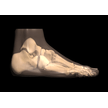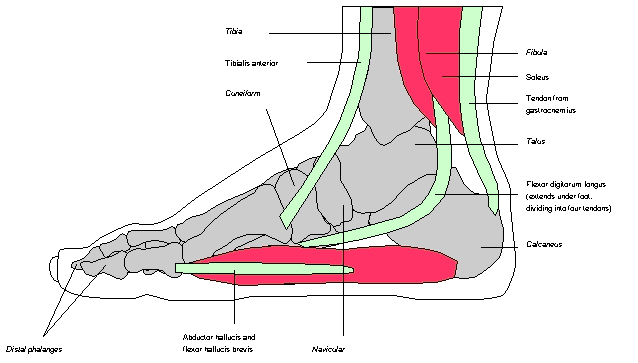 Ankle
Sprains
Ankle
Sprains
This article is intended as an overview --- to provide basic familiarity with the types of problems faced by martial artists where their feet are concerned --- but with an eye towards prevention, not treatment or diagnosis. While the problems discussed may sound familiar, this article is no substitute for an examination by a qualified health professional. Because complex or serious problems can often look like simple ones (and delays in diagnosis can lead to prolonged healing times or even permanent damage), you should check with your physician/provider for the most accurate diagnosis and individualized treatment.
 General
comments
General
comments
Like any type of injury, foot and ankle problems in martial artists can be classified many different ways. Students of the grappling arts like judo and jiu-jitsu, which emphasize leveraging moves and application of full body weight, tend to have different ankle problems than those from more percussive styles like karate-do and tae kwon do, which generally emphasize rapid foot strikes and ballistic contact. Students who spar and compete, with the emphasis on more all-out, unexpected contact, tend to have different problems than those who do not, where the contact is controlled or even eliminated (e.g. kickboxing for fitness).
In the real world, however, everybody overlaps a surprising amount: if you're active and stick with your chosen art long enough, you'll eventually duplicate the striking, twisting, and just plain abusing mechanisms of any of your fellow martial artists. And with just a little knowledge and foresight, you can care for the foot and ankle injuries that result in a way that returns you to training in as rapid and safe a way as possible --- or even prevents the injuries before they occur.
 Ankle
Sprains
Ankle
Sprains
Although the ankle isn't technically part
of the foot and toes, it deserves special mention because injuries to it
are so common to all martial arts. Whether you stand and kick, step and
punch, turn and throw, or shuffle and lunge, you are at risk for injuring
the one joint that bears your body weight through a large range of motion
with every move.
Most ankle sprains involve the foot "turning
under" as you bring your weight to bear on the outer edge of your foot.
This action can stretch out and tear the ligaments on the outside of the
ankle --- the "straps" that hold the bones together. But you can also injure
these ligaments by banging your heel hard enough to push the foot forward
ahead of your shin (i.e. "heel kicking" the floor as you land in a breakfall),
or by twisting your leg over a foot that's fixed to the floor.
The main clues to this problem are swelling on one or both sides of the ankle bone knobs, accompanied by pain or difficulty putting weight on the foot. While making the diagnosis yourself may seem obvious, this injury is a prime example of "taking it to the doc" being the most prudent course of action. Forces that can sprain ankles can also break bones and chip cartilage within the ankle joint, foot, and the lower leg, and even physicians can have a hard time catching these complications without x-rays and careful examinations. And even if the diagnosis is a simple ankle sprain, remember that the most common cause of ankle sprains is the previous sprain that was never properly rehabilitated. So if it puffs up or it's hard to walk on it, get it checked out and formally treated.
If you've recently sprained an ankle, the best prevention for future re-sprains is retraining your ankle muscles and proprioception --- the sense of how your foot is tilted relative to the ground. Both take a beating when you suffer a sprain, leading to a weakened foot that is slightly turned-under when you "think" that it's meeting the ground squarely, which can lead to a re-sprain. Physical therapy is the safest course for a rapid return to full, uninterrupted practice after a major sprain.
 Toe
and Foot Trauma
Toe
and Foot Trauma
Students of percussive arts are particularly at risk for injuries to the toes and feet if not using protective footwear, but blunt trauma can also occur to those practicing grappling or even non-contact styles. Fractures can happen in judo when toes get entangled in gi's during full power throws, and feet can get badly bruised in non-competitive kickboxing classes when a bare foot strikes a partner's elbow or equipment buckle during a kicking drill.
Turf toe is relatively unique to those practicing takedowns, and sprains of the great toe are common to anyone working out on cushioned mats, particularly gymnastic style mats as opposed to canvas or tatami-like surfaces. Originally named after the Astroturf injury suffered by football players, turf toe occurs when the foot/big toe joint gets sprained during an abnormally severe bend (i.e. toes on the mat when dropping to one knee during a throw). The big toe joint (the "knuckle" in the toe itself) can also get sprained, usually from a snagging mechanism like catching the toe on a soft mat and having the tip forcibly bend under. This is a powerful argument for upgrading a club's padded training surfaces, as this problem largely self-corrects when toes can avoid catching on "grabby" vinyl surfaces or large gaps between mats. Buddy taping the big toe to the 2nd toe with athletic tape can also help to support the big toe, lessening the chance of either injury.
Fractures, or actual breaks, in bones of the toes or feet, can occur with any severe impact or prying injury. Buddy taping toes in groups of two can make fractures less common, at the sacrifice of a little traction; learning techniques properly to avoid unintended impacts during the heat of all-out practice may actually do the most good. Like the ankle, broken toe/foot bones can look like bad sprains, so any persistent swelling and pain, particularly around where the toes meet the foot, should be evaluated by a physician; some fractures need to be fixed with surgery.
Toenail avulsions (ripping off) and subungual hematomas (blood bruises under the nails) happen almost exclusively from direct or glancing nail hits. Like fractures, they are a risk with any kind of all-out practice, particularly without protective footwear, and are otherwise difficult to prevent directly. A physician may choose to re-attach a detached nail as a healing splint, or to relieve the exquisite tenderness of a blood bruise by removing the blood while it's still fluid, so seeking medical attention quickly is prudent in these cases, too.
Tendon sheath trauma on the top of the foot can be incredibly painful --- the aforementioned kicking of an elbow or equipment buckle is the usual mechanism. The tendon straps running atop the foot bones are easily pinched, and can rapidly swell and make even walking difficult. "Conditioning" this area (skin over tendons and tendon sheaths) is considered possible in some styles, but is more difficult to accomplish than conditioning the shin surfaces (skin over bone). Protective gear and carefully practicing kick placement may be a more valuable in the long run: preventing the mechanism of injury can mean the avoidance of weeks of recuperation time.
 General
Preventive Foot Care
General
Preventive Foot Care
Finally, what perhaps should be "first" in mind where foot and ankle health is concerned: daily foot care and preparation for training. Aside from what should be routine for reasons of safety --- keeping toenails trimmed short to avoid inflicting cuts, taping or bracing of toes and ankles --- certain conditions merit attention for reasons of hygiene and courtesy to your fellow practitioners and school.
Plantar warts are foot growths triggered by a viral skin infection --- and are especially "catchy" among members of a martial arts school or club. While they will eventually disappear on their own, this process can take years; meanwhile, constantly rubbing them on the mat or floor can seed these training surfaces with the virus and spread the warts to your fellow partners. Students of grappling arts are particularly at risk, since matwork places arms, hands, and face in contact with the floor, leading to more widespread lesions.
Tinea pedis, commonly known as "ringworm" when it occurs on the body, isn't actually a worm, but rather a fungus that causes a circular or ring-shaped, itchy rash. On the feet, it creates a generally scaly, intensely itchy rash, and like warts, is easily transmitted to others via a shared training surface.
Onychomycosis, or toenail fungus,
causes a darkening and thickening of the toenails, eventually leading to
accumulated debris underneath that lifts the nail off the underlying nail
bed. While most folks don't normally contract this infection, those at
risk are people who experience nail trauma and cracking, allowing the fungus
to "enter" the nail through the cracked end --- which means most martial
artists who practice without footwear.
All of these infections are treatable
with either topical creams or prescription pills, and should be addressed
immediately when found. A program of mat or floor cleansing should be standard,
every 1-3 months with a commercial-grade germicidal/virucidal/fungicidal
agent; wearing sandals to keep your feet clean when not on the mat or training
floor (and not wearing street shoes or other "contaminating" footwear on
the mat) should also be routine. It seems silly until you get a "social"
infection that takes months to get rid of, while itching and bringing it
home to friends or family.
Peter Kim is a practicing family medicine and sports medicine (sport medicine to Canadians) physician in Costa Mesa, California, a member of the U.S. Judo Medical Subcommittee, fellowship-trained in sports medicine and a holder of the CAQ in Sports Medicine from the American Academy of Family Physicians. He practices aikido, iaido, and judo, and has past training experience in savate, jeet kune do, kali-silat, Muay Thai, and Brazilian jiu-jitsu.
